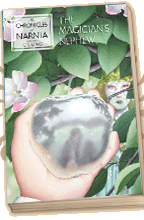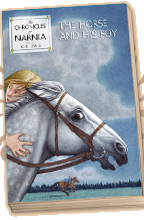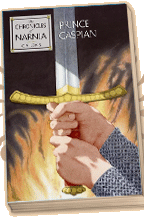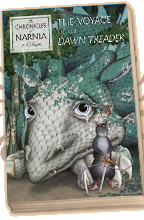The Seven Books
C.S. Lewis
Narnia on Media
Discover Narnia
Contact

|
|
The Magician's Nephew
English Year 1900
Narnian Year 1

Digory and Polly discover a secret passage that links their houses, and are tricked into vanishing out of this world and into the World of Charn, where they wake up the evil Queen Jadis. There, they witness the creation of the Land of Narnia, as it is sung into being by the Great Lion, Aslan.

|
| |
|
The Lion, The Witch and
The wardrobe
English Year 1940
Narnian Year 1000

Peter, Susan, Edmund, and Lucy find their way through an old wardrobe into the world of Narnia. There, they unite with Aslan to fight the White Witch and save Narnia from perpetual Darkness.

|
| |
|
The Horse and His Boy
English Year 1940
Narnian Year 1014

Shasta escapes from the land of Calormen with a Narnian warhorse, Bree. Along with Aravis and her horse Hwin, they uncover a Calormene plot to conquer Narnia and must find a way to save Narnia and its people.

|
| |
|
Prince Caspian
English Year 1941
Narnian Year 2303

Troubled times have come to Narnia as it is gripped by civil war. Prince Caspian is forced to blow The Great Horn of Narnia, summoning the help of past heroes, Peter, Susan, Edmund, and Lucy. Now they must overthrow Caspian's uncle, King Miraz, to restore peace to Narnia.

|
| |
|
The Voyage of 'Dawn Treader'
English Year 1942
Narnian Year 2306

Lucy, Edmund, and their cousin Eustace, are magically transported onto the ship, Dawn Treader, where King Caspian is searching for the seven lost friends of his father. On the voyage, the children meet many fantastical creatures, including the great Aslan himself.

|
| |
|
The Silver Chair
English Year 1942
Narnian Year 2356

King Caspian's beloved son Prince Rilian has disappeared. Aslan sends Eustace and his school friend Jill to Narnia on a quest to search for the young prince and defeat the evil Witch.

|
| |
|
The Last Battle
English Year 1949
Narnian Year 2555

A false Aslan is roaming Narnia, commanding everyone to work for the cruel Calormemes. Can Eustace and Jill find the true Aslan and restore peace to the land? The last battle is the greatest of all and the final struggle between good and evil.

|
| |
Reading order
Fans of the series often have strong opinions over the correct ordering of the books. When the books were originally published, they were not numbered. The first American publisher, Macmillan, put numbers on the books in the order in which they were published. When HarperCollins took over the series in 1994, the books were renumbered using the internal chronological order, as suggested by Lewis' stepson, Douglas Gresham.
Publication order vs. Chronological order
| Publication order |
Chronological order |
| The Lion, the Witch and the Wardrobe |
The Magician's Nephew |
| Prince Caspian |
The Lion, the Witch and the Wardrobe |
| The Voyage of the Dawn Treader |
The Horse and His Boy |
| The Silver Chair |
Prince Caspian |
| The Horse and His Boy |
The Voyage of the Dawn Treader |
| The Magician's Nephew |
The Silver Chair |
| The Last Battle |
The Last Battle |
To make the case for his suggested order, Gresham quoted Lewis' reply to a letter from an American fan in 1957 who was having an argument with his mother about the order:
“I think I agree with your order [i.e. chronological] for reading the books more than with your mother’s. The series was not planned beforehand as she thinks. When I wrote The Lion I did not know I was going to write any more. Then I wrote P. Caspian as a sequel and still didn't think there would be any more, and when I had done The Voyage I felt quite sure it would be the last. But I found as I was wrong. So perhaps it does not matter very much in which order anyone read them. I’m not even sure that all the others were written in the same order in which they were published.” (Dorsett & Mead 1996)
In the HarperCollins adult editions of the books (2005), the publisher asserts Lewis' preference for the numbering they adopted in a notice on the copyright page:
Although The Magician's Nephew was written several years after C.S. Lewis first began The Chronicles of Narnia®, he wanted it to be read as the first book in the series. HarperCollins is happy to present these books in the order which Professor Lewis preferred.
Some fans of the series who appreciate the original order believe that Lewis was only being polite to a child, and that he could have changed the order in his lifetime had he so desired (Brady 2005). They maintain that much of the magic of Narnia comes from the way in which the world is gradually presented in The Lion, the Witch and the Wardrobe. They believe that the mystery of the wardrobe is narratively a much better introduction than in The Magician's Nephew — where the word "Narnia" is the fortieth word in the book. Moreover, they say that it is clear from the texts themselves that The Lion, the Witch and the Wardrobe was intended to be the first book read, and that The Magician's Nephew was not. For instance, in The Lion, the Witch and the Wardrobe, when Aslan is first mentioned, the narrator states, "None of the children knew who Aslan was, any more than you do." Fans of the original order say that that statement is nonsensical if one has already read The Magician's Nephew. Other similar textual examples are also cited. This argument hinges partly on the claim that Chronology is not equivalent to Narrative (Rilstone 2004).
|
|






